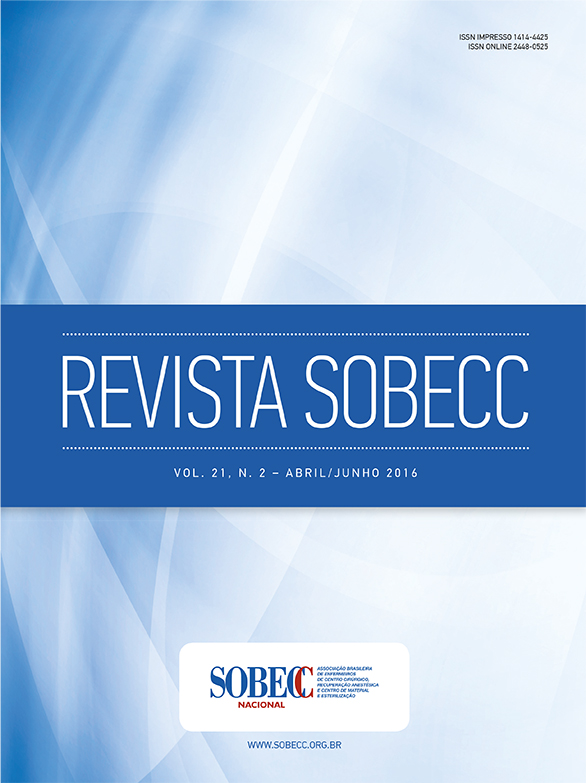Knoted guidewire in peripherally inserted central catheters (PICC): a rare complication.
DOI:
https://doi.org/10.5327/Z1414-4425201600020008Keywords:
Catheters. Complications. Surgical procedures, operative. Patient care team.Abstract
Objective: To report the experience of a multiprofessional team on the management of an adverse event after the insertion of a peripherally inserted central catheter (PICC) because of the retention of the metallic guidewire. Method: An experience report concerning an occurrence at a general hospital in the city of Guarulhos, São Paulo, Brazil, in November 2015. Results: Description of the case of a 1-year-old infant, with hemophilia and neuropathy, who had its guidewire held after the insertion of a PICC 3F in the forearm without incidents, which made its removal impossible. Radioscopy revealed that the guidewire was curled up and had to be surgically removed. Conclusion: The surgical procedure was successful. There was no blood loss in the operating field. The infant recovered well, without any consequences detected because of the complication. The manufacturer was notified of the event. This case served as a learning experience for the multiprofessional team.References
Wrightson DD. Peripherally inserted central catheter complications in neonates with upper versus lower extremity insertion sites. adv Neonatal Care. 2013;13(3):198-204.
Baggio Ma, Bazzi FCS, Bilibio CaC. Cateter central de inserção periférica: descrição da utilização em uTI neonatal e pediátrica. Rev Gaúcha enferm. 2010;31(1):70-6.
Jumani K, advani S, Reich NG, Gosey l, Milstone aM. Risk factors for peripherally inserted central venous catheter complications in children. JaMa Pediatr. 2013;167(5):429-35.
Pettit J. assessment of infants with peripherally inserted central catheters: Part 1. Detecting the most frequently occurring complications. adv Neonatal Care. 2002;2(6):304-15.
Secoli SR, Jesus vC. Complicações acerca do cateter venoso central de inserção periférica (PICC). Ciênc Cuid Saúde. 2007;6(2):252-60.
Conselho Regional de enfermagem de São Paulo. Parecer Coren-SP CaT nº 006/2010. Técnica de Seldinger modificada para punção arterial. [acesso em 29 janeiro 2016]. Disponível em: http://portal. coren-sp.gov.br/sites/default/files/parecer_coren_sp_2010_6.pdf
altıntaş G, Diken aİ, ulaş MM, Çiçek ÖF, Özen a, Ökten S, et al. Surgical removal of a knotted and entrapped subclavian hemodialysis catheter guidewire. ann vasc Surg. 2012;26(3):421.e17-9.
Khan KZ, Graham D, ermenyi a, Pillay WR. Case report: managing a knotted Seldinger wire in the subclavian vein during central venous cannulation. Can J anaesth. 2007;54(5):375-9.
Fiala a, Glodny B, lorenz IH. Knotted Seldinger wire. anaesthesist. 2016;65(1):42-5.
Ohki Y, Maruyama K, Harigaya a, Kohno M, arakawa H. Complications of peripherally inserted central venous catheter in Japanese neonatal intensive care units. Pediatr Int. 2013;55(2):185-9.
Kurtom W, Degnan a, Quast D. Knot formation of a neonatal peripherally inserted central catheter: a rare complication of placement. J vasc access. 2016;17(1):e15-6.
Oliveira CR, Neve eT, Rodrigues eC, Zamberlan KC, Silveira a. Cateter central de inserção periférica em pediatria e neonatologia: possibilidades de sistematização em hospital universitário. esc anna Nery. 2014;18(3):379-85.
Downloads
Published
How to Cite
Issue
Section
License
By publishing in Revista SOBECC, authors retain the copyright of their article and agree to license their work using a Creative Commons Attribution (CC BY 4.0) International Public License, thus accepting the terms of this license. The CC BY 4.0 license allows others to distribute, remix, adapt, and create from the published article, even for commercial purposes, provided they give due credit to the creators of the work (authors of the article).
The authors grant to Revista SOBECC the right of first publication, to identify itself as the original publisher, and grant to the journal a non-exclusive license to use the work in the following ways: (1) to sell and/or distribute the article in hard copies and/or in electronic format; (2) to distribute parts and/or the entire article in order to promote the journal through the internet and other digital and printed media; (3) to record and reproduce the article in any format, including digital media.
With this license, authors can enter into separate contracts for non-exclusive distribution of the article (e.g., publishing in an institutional repository or as a book chapter), with acknowledgement of authorship and initial publication in Revista SOBECC. Authors are encouraged to publish and distribute their work online after publication in the Revista SOBECC, as this can increase the article's visibility and impact.
In line with the journal's policies, each published article will be assigned a CC BY 4.0 license, which will be visible on the abstract page and in the PDF of each article with the respective link to the license terms.











